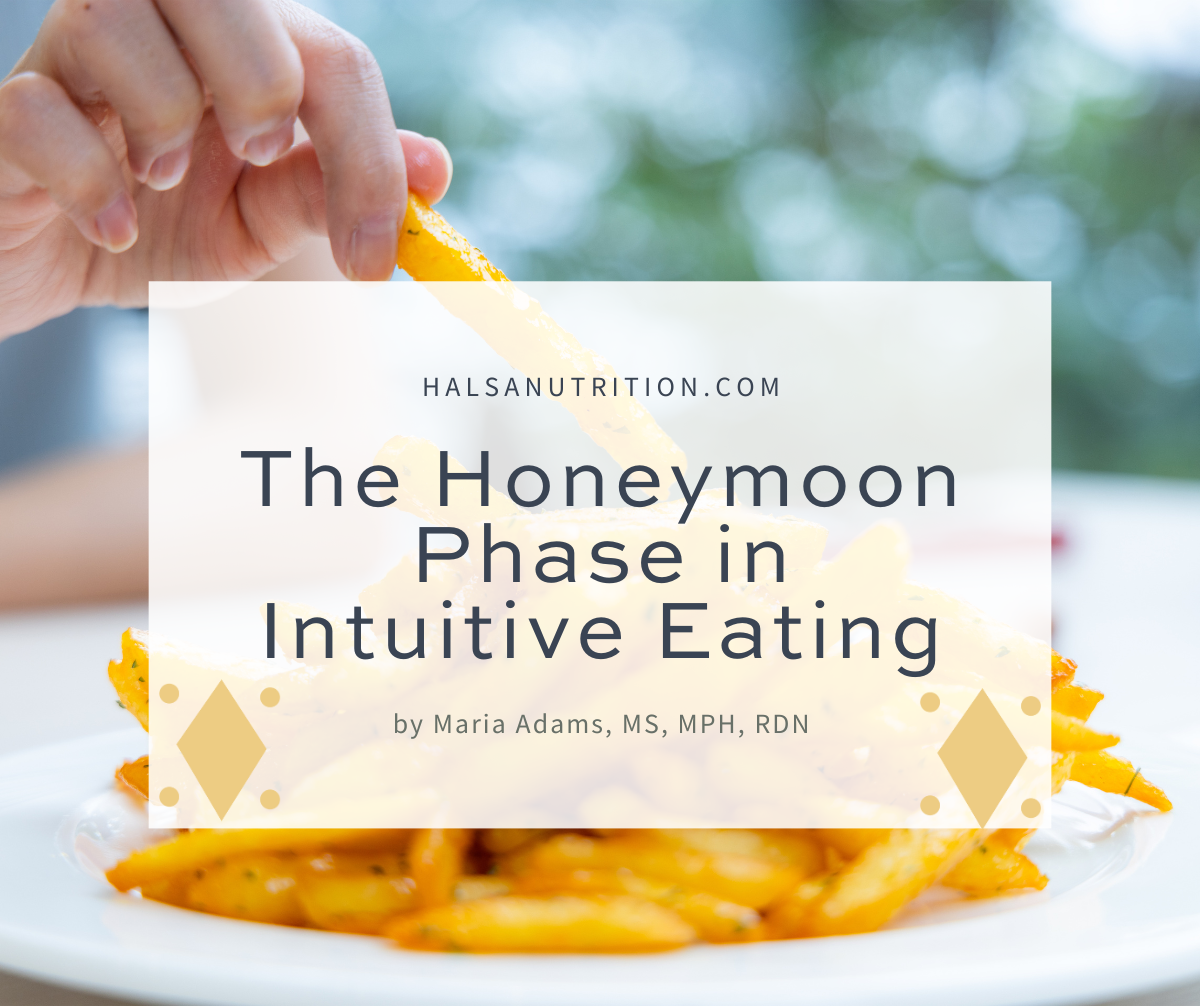
The Honeymoon Phase in Intuitive Eating
Estimated reading time: 9 minutes
What is the honeymoon phase in intuitive eating?
The honeymoon phase refers to a period of time after a person first adopts intuitive eating and finds themselves finally “allowed” to eat all their previously restricted foods. Intuitive eating entails giving yourself unconditional permission to eat, which can be an exciting but scary mindset for many.
When people first hear of intuitive eating, they may think,
“Well, that sounds nice, but my intuition would tell me to eat pizza and cupcakes all day.”
“I can’t keep chocolate in the house because I will just want to eat it all the time. Intuitive eating won’t work for me.”
“My intuition will tell me to eat more than I should.”
Many people find some truth to these statements when they first give themselves food freedom. However, this phase is temporary.
Why does the honeymoon phase happen?
The honeymoon phase happens because you have been restricting food in some way, whether physically or mentally. A physical restriction entails limiting or avoiding certain foods, only eating certain foods on special occasions, or not eating enough. Mental restriction means that you may still allow yourself to eat all foods but feel guilty when you eat certain foods.
Many people allow themselves to eat enough, as long as it’s food that they consider “healthy” or “clean.” It’s one thing to restrict foods you don’t like or can’t tolerate (e.g., due to a food allergy or sensitivity), but if you want a food and don’t let yourself have it because it’s not “healthy,”–that’s diet culture restriction.

The Binge-Restrict Cycle
It can be helpful to think about the binge-restrict cycle that often happens with dieting or restriction. When we restrict food–mentally or physically–we generally feel deprived. We may experience intense cravings. Eventually, we may give in and eat the “forbidden food,” perhaps in larger quantities than is comfortable, making us feel out of control around this food and ashamed of our behaviors.
With intuitive eating, we interrupt this cycle by giving ourselves unconditional permission to eat any food–and as much of it as we want. Saying “yes” to previously forbidden foods is exciting, which is why it’s known as the honeymoon phase in intuitive eating. This newfound food freedom may lead to eating more of the previously restricted foods and eating past the point of comfort for a period when it’s first adopted. But with continued unconditional permission to eat, trust is built and food loses its power.
The Habituation Effect
The habituation effect is part of the intuitive eating process and relates to the honeymoon phase. It refers to the fact that a novel item loses its appeal with regular exposure. For example, if you never have chips in the house because you feel like you shouldn’t eat them or will overeat, you may eat them in excess when you do have them. But they lose their appeal and excitement if you have chips available daily.
How long does the honeymoon period last?
The honeymoon phase can last for any amount of time. It varies from person to person and is influenced by factors such as a person’s history of dieting and restriction, past experiences, current support systems, and individual habits and tendencies.
Intuitive eating is not a linear path, so it’s possible to experience this phase in shorter bits and pieces or for a long time. It’s also possible to skip right over it–not everyone experiences this phase.
Learning to tune into our hunger and fullness signals, discovering satisfaction, and making peace with foods are all components of intuitive eating, which will help you navigate the honeymoon phase. Rejecting diet culture is also essential.

The honeymoon phase and family eating
Navigating the honeymoon phase can be particularly challenging for families. It’s one thing for you to adopt intuitive eating for yourself, but implementing it for your family can feel a bit chaotic at first. But the good news is that adopting an intuitive eating mindset for your family is possible.
The Division of Responsibility Can Help with the Honeymoon Phase
A helpful suggestion is to keep the division of responsibility (DOR) practice in place. This will help you navigate childhood feeding with confidence. As a reminder, the DOR theory suggests that parents or caregivers should be responsible for what, when, and where to eat while kids decide whether to eat and how much.
For example, the parent decides whether ice cream will be served as dessert or Halloween candy will be part of the after-school snack. But then your child can choose how much of the offered ice cream and candy they eat.
The DOR reminds us that parents still have some control over what their kids eat, and it allows kids to learn to trust their bodies.
What to Expect When You First Implement Intuitive Eating with Kids
When first implementing intuitive eating, your kids might experience the honeymoon phase themselves. For example, they may choose to barely eat dinner and then eat an abundance of ice cream. Or maybe they eat so much Halloween candy that they get a stomach ache. This is normal and ok.

When you consistently implement the DOR and intuitive eating practices, you are promoting a healthy relationship with food. Your child will start to trust that these delicious foods will be available to them again and be less likely to eat past the point of comfort. (Though it may still happen occasionally–especially when a favorite food is served!) But if you repeatedly restrict what or how much they can eat, there’s a good chance they will stop trusting you–and themselves. This can lead to eating the restricted food in secret, overeating more often, or overindulging when the restricted food is available.
Reminder: Parents Are Still in Charge with Intuitive Eating
Implementing intuitive eating and DOR does not mean you’ve put your child in full charge. You are still deciding what foods to buy for your home, what to make for dinner, the time of meals, etc. It’s also important to remember that you can say “no” to a child’s food requests. But how you say “no” and in what context matters.
For example, if your child asks for candy at breakfast, rather than just saying no, it can be helpful to say, “We are having eggs, fruit, and toast for breakfast. We will have candy as part of your afterschool snack this afternoon.” Of course, you could say no, but there is a lot of nuance involved here; the key is that they don’t feel it’s restricted.
Similaly, If you decide to have ice cream for dessert, let your children enjoy it unconditionally. Don’t make it conditional on whether they have eaten their dinner. And be sure to allow them to eat until satisified. Another strategy is to offer dessert at the same time as the meal. This can diminish dessert’s power and lead to more peaceful mealtimes during this honeymoon period.
Serve Previously Restricted Foods More Regularly
When it comes to fun foods like candy and chips, it’s important to enjoy them year-round and not just on special occasions or holidays. This doesn’t mean they need to be part of the daily diet, but they should be offered regularly enough not to be viewed as “forbidden” or “scarce.” This type of restriction can lead to overeating, sneaking food, and eating disorders.
How to Navigate the Honeymoon Phase with Adolescents
As your child enters their tween and teen years, you will naturally have less control over their eating. Giving them a childhood rooted in intuitive eating will help prepare them for a lifetime of nourished eating habits and a healthy relationship with food.
That said, this doesn’t always happen. If you have struggled with feeding your kids or found yourself often doing the opposite of what the DOR suggests, it’s okay. It’s never too late to implement intuitive eating. Recognize that your intentions came from a place of love and that parenting is no easy feat! Moreover, every child is different; in some situations, parents need to intervene more with their child’s eating. This could be due to a health condition, eating disorder, neurodiversity, or something else.
Use the DOR as a guide for implementing intuitive eating in your family. For more help in this area, check out the resources below.
Key Tips for Navigating the Honeymoon Phase in Intuitive Eating
- Know that the honeymoon phase is temporary.
- Understand why the honeymoon phase is happening.
- Trust the process; know that it will feel a little messy, and that’s okay.
- Use the DOR as a guide for feeding kids.
- Seek additional support if you need it. Certified intuitive eating counselors and registered dietitians are here to support you!
Resources
Books:
Disclosure: Some of the links below are Amazon affiliate links. This means that at no additional cost to you, if you click through and make a purchase I will earn a commission.
- Intuitive Eating by Evelyn Tribole and Elyse Resch
- Intuitive Eating Workbook by Evelyn Tribole and Elyse Resch
- How to Raise an Intuitive Eater by Sumner Brooks and Amee Severson
- Child of Mine by Ellyn Satter
Counseling:
- Seek out a dietitian who is a Certified Intuitive Eating Counselor
- Halsa Nutrition’s services
Additional blog posts:
- How to Eat for Sustained Energy and Reduced Sugar Cravings
- How Intuitive Eating Affects Health Markers
- The 10 Principles of Intuitive Eating Help You to Be Kind to Your Body
- The Division of Responsibility
- How to Handle All That Halloween Candy
About the Author
Maria Adams, MS, MPH, RDN, LDN, a registered dietitian and Certified Intuitive Eating Counselor. Maria takes a weight-inclusive approach and helps individuals rediscover the joy of food, learn how to nourish to feel their best, and heal from chronic dieting and disordered eating. She holds a Bachelor of Science Degree in Nutrition Science, a Master of Science in Nutrition Communication, and a Master of Public Health.
Leave a Reply